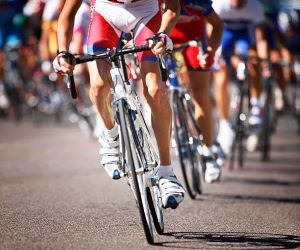Master endurance cycling in tropical climates with effective strategies. Learn hydration, heat adaptation, and training tips for peak performance.
WHAT ARE THE BEST HEART RATE ZONES FOR CYCLING TRAINING?
Heart rate training is one of the most effective ways for cyclists to improve fitness systematically. By dividing effort into zones based on your maximum heart rate, you can tailor workouts for endurance, speed, and recovery. Training in the right heart rate zone ensures you push hard enough to adapt without risking overtraining. This guide explains the five main cycling heart rate zones, their physiological benefits, and how to apply them in structured training. Whether you’re a beginner or an experienced racer, understanding these zones unlocks smarter, more efficient rides.

The science behind heart rate zones
Heart rate zones are training ranges based on percentages of your maximum heart rate (MHR). Each zone represents a different level of intensity, stimulating specific physiological adaptations. By targeting zones strategically, cyclists can train endurance, aerobic capacity, or sprint power without guesswork.
The most common formula to estimate maximum heart rate is 220 minus your age, though more accurate results come from lab testing or field tests. Once you know your MHR, training zones are typically divided into five categories ranging from very light to maximum effort. These zones help athletes understand not just how hard they are working, but also what benefit they are gaining.
Core principles of heart rate training
Zone 1 (50–60% MHR): Active recovery, gentle pedaling, and circulation boost.
Zone 2 (60–70% MHR): Aerobic base building, fat metabolism, and endurance.
Zone 3 (70–80% MHR): Tempo riding, muscular endurance, and steady-state effort.
Zone 4 (80–90% MHR): Threshold training, lactate control, and race pace practice.
Zone 5 (90–100% MHR): Anaerobic capacity, sprint power, and high-intensity intervals.
Cyclists benefit from understanding that not every ride should push the limits. Training too often in high zones can cause burnout, while focusing on lower zones without intensity caps performance. A structured balance across all zones builds a complete athlete capable of endurance, speed, and recovery.
In essence, heart rate zones provide a scientific roadmap for cycling progress. They turn subjective “effort” into measurable data that aligns training with performance goals.
Applying heart rate zones to training
Knowing your zones is only the first step; applying them correctly determines success. Different workouts target different adaptations, and cycling performance improves most when training balances low-intensity endurance rides with strategic high-intensity sessions.
Zone 1 is best for active recovery rides after hard sessions. Zone 2 forms the foundation of most training, especially for endurance athletes, as it trains fat metabolism and aerobic efficiency. Zone 3, while not as glamorous, builds muscular endurance and is key for riders tackling long sportive or Gran Fondo events.
Zones 4 and 5 are where speed and race performance are sharpened. Zone 4 sessions simulate time trial or breakaway efforts, teaching the body to tolerate and clear lactate. Zone 5 efforts, like intervals or sprints, push your anaerobic system and increase maximal power output. These sessions should be used sparingly but strategically for peak performance.
Sample cycling workouts by zone
Zone 1: 45 minutes of easy spinning after a race for active recovery.
Zone 2: 2–4 hours of steady riding at conversational pace.
Zone 3: 3×20 minutes at tempo pace with 10-minute recoveries.
Zone 4: 4×8 minutes at threshold with equal recovery periods.
Zone 5: 6×1-minute all-out sprints with 3-minute recoveries.
Cyclists should periodize their use of heart rate zones. Early season training may focus heavily on Zones 1 and 2, while race preparation phases integrate more Zone 4 and 5 work. This structured approach prevents burnout while ensuring continuous improvement.
Practical application also means adjusting for external factors. Heat, stress, hydration, and fatigue can all elevate heart rate, making zone adherence less precise. Combining heart rate data with perceived exertion or power meters enhances accuracy.
Ultimately, heart rate zones transform cycling into a science-backed journey. By applying them wisely, cyclists ensure every ride has a purpose — whether it’s recovery, endurance building, or peak race performance.
Maximizing performance with balanced training
The real power of heart rate zones lies in balance. Cycling performance is not built in a single zone but through the integration of all five. Riders who spend too much time in “grey zone” efforts (between endurance and threshold) often plateau, while those who skip recovery risk chronic fatigue. The best training plans orchestrate each zone into a cohesive cycle of stress and adaptation.
One proven model is polarized training: spending about 80% of training time in low-intensity Zones 1–2 and 20% in high-intensity Zones 4–5. This method has been shown to maximize endurance while still developing peak performance. Another approach, sweet spot training, emphasizes Zone 3–4 work to efficiently build threshold power for time-crunched cyclists.
Cyclists should also account for long-term adaptation. Zone 2 rides may feel uneventful, but they steadily enhance mitochondrial density and fat utilization — foundational changes that support harder efforts. Conversely, short bursts in Zone 5, though exhausting, elevate VO2 max and sprint capacity, unlocking competitive edges in races.
Best practices for long-term progress
Prioritize consistency: steady training in all zones beats sporadic intensity.
Respect recovery: Zone 1 rides and rest days are essential for adaptation.
Use variety: mix endurance, tempo, threshold, and sprint sessions for complete fitness.
Adapt plans: adjust zones based on fatigue, terrain, and personal goals.
Heart rate training is also a mental game. Learning to ride with discipline — holding back in low zones or pushing into discomfort at high zones — builds resilience. Over time, this mental toughness translates into confidence on race day.
By balancing efforts across heart rate zones, cyclists achieve sustainable gains. They build endurance engines, sharpen competitive speed, and avoid the pitfalls of overtraining. The result is a rider not just fit for a single event, but resilient across seasons and challenges.
YOU MAY ALSO BE INTERESTED






